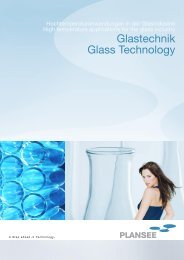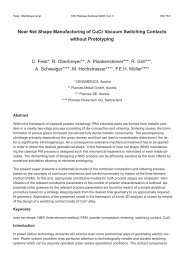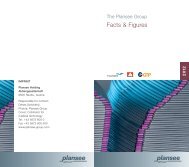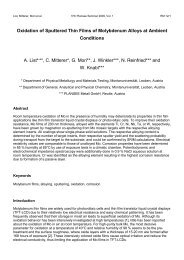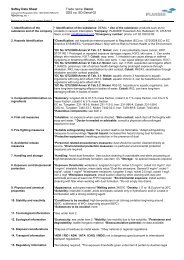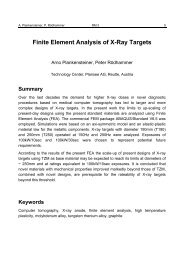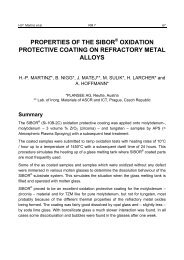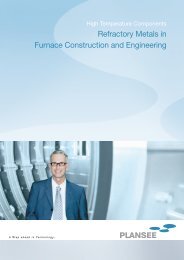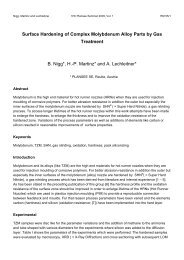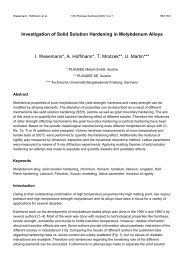Fracture Toughness of Polycrystalline Tungsten Alloys
Fracture Toughness of Polycrystalline Tungsten Alloys
Fracture Toughness of Polycrystalline Tungsten Alloys
Create successful ePaper yourself
Turn your PDF publications into a flip-book with our unique Google optimized e-Paper software.
RM 21/6 17th Plansee Seminar, Vol. 1 Gludovatz, Wurster et al.<br />
(a) RT (b) 300 ◦ C (c) 600 ◦ C<br />
Figure 7: Plastically deformed areas along the crack paths <strong>of</strong> tungsten rhenium CT-specimens tested at RT (a),<br />
300 ◦ C (b) and 600 ◦ C (c).<br />
always in the range between 4 and 6 degrees. However the frequency <strong>of</strong> deformed grains is increasing<br />
with increasing temperature. In the case <strong>of</strong> RT - and 300 ◦ C-tested specimens the deformation was just<br />
observed directly along the crack path whereas the 600 ◦ C-tested specimen showed plastically deformed<br />
areas also in a wider vicinity <strong>of</strong> the propagated crack.<br />
The compact tension specimens manufactured <strong>of</strong> a W26Re alloy were fractured at room temperature and<br />
at elevated temperatures. Figure 7 shows scans <strong>of</strong> all specimens after fracture. Compared to the AKS-<br />
W-specimens these IPF show much more plastically deformed areas. Plastically deformed grains in the<br />
direct vicinity <strong>of</strong> the propagated crack were just observed at the RT -tested specimen (fig. 7-a). The 300 ◦ Cand<br />
600 ◦ C-tested samples (fig. 7-b and fig. 7-c) show also plastification in the wider vicinity <strong>of</strong> the crack.<br />
Measured misorientations <strong>of</strong> about 10 degrees at the 300 ◦ C- and about 14 degrees at the 600 ◦ C-tested<br />
specimens are much higher than the values <strong>of</strong> the AKS-W-specimens.<br />
In order to quantify the effect <strong>of</strong> local varying fracture resistances further investigations on different microstructures<br />
will be performed and described in a forthcoming paper.<br />
Acknowledgements<br />
The financial support by the “Christian Doppler Forschungsgesellschaft” is gratefully acknowledged.<br />
A part <strong>of</strong> this work, supported by the European Communities under the Contract <strong>of</strong> Association between<br />
EURATOM and the Austrian Academy <strong>of</strong> Sciences, was carried out within the framework <strong>of</strong> the European<br />
Fusion Development Agreement. The views and opinions expressed herein do not necessarily reflect those<br />
<strong>of</strong> the European Commission.<br />
The interesting discussions with Pr<strong>of</strong>. R. Stickler and provided documents is thankfully acknowledged.



